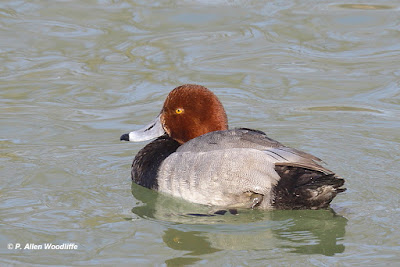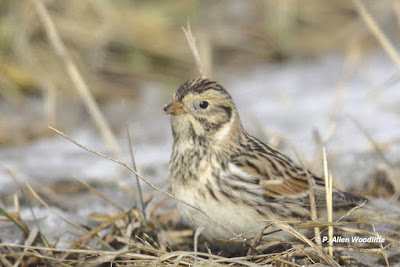It looks like we are going to get a taste of spring or at least a teaser, as locally, the temperatures for the next 10 days are forecast to be slightly above freezing. With the warmer day time temperatures, and the still below freezing night time temperatures, I expect that those people in the maple syrup producing business will be getting excited.
There actually have been a few hints of spring besides the weather or the progressing days on the calendar. Indeed, waterfowl have started to pair up, and their feathered plumage looks fresh and inviting. A recent check of the water outlet along the Thames River has some impressively plumaged birds.
A male Redhead, shown first, is looking dapper.
There have been at least three Wood Ducks at this spot, but this photo just shows the not-to-be-confused with any other duck species colouration. Although they are smaller than a Mallard, it was interesting to watch them act aggressively towards the Mallards, getting them to move out of the way.
 |
| American Black Duck |
In spite of the Mallard, or 'greenhead', being so abundant and taken for granted, there is no question that it is a distinct and nice looking bird.
The female, shown next, is much more subtle.
 |
| Common Goldeneye, female |
 |
| Hooded Merganser, female |
Snow Geese are not to be expected at this location. But for one day, six of them were hanging out. There were 4 white birds and two of the 'blue' colour phase.
Even some of the adult gulls, such as this Herring Gull, are looking crisper and cleaner in their developing breeding plumage.
Other signs of spring are around. For example it is a good idea to check existing raptor nests, especially those of Bald Eagles. I checked the one just east of St. Clair NWA on the weekend, and saw a full adult at the nest. It was hard to tell if it was incubating due to all the branches, or whether it was just inspecting the nest. Regardless, other eagle nests such as the one near Shrewsbury in south Chatham-Kent have had an adult sitting in an incubating posture for several days now, so the nesting has begun for that species. While I was checking the nest near SCNWA, a 4th year eagle was soaring over the road I was on and I got a few quick photos. The head and tail are not completely white like a full adult, but it is developing as a probable 4th year bird, and 4th year birds are known to be of breeding age. It was not conclusive whether this is the mate of the one on the nest, but being as close as it was, is possible.
Another sign of approaching spring is the arrival of so many Horned Larks. There are hundreds and hundreds of them along the roadsides. They are one of the earliest migrants to return and while they aren't quite into nesting mode, it won't be long before they are paired up and establishing their territory.
In addition to Horned Larks along the roadsides and fields, there are lots of Snow Buntings to enjoy. They've got a long way north to go before they get to their breeding grounds.........as have Lapland Longspurs. They are not nearly as numerous as the previous two species shown.
An even more careful look at some of the roadside birds may turn up a Savannah Sparrow, a quite uncommon species here in mid-winter.
In other news, there are still flocks of geese and swans around. It wasn't that long ago that seeing Tundra Swans in winter was quite unusual, but with the shortening of winter in recent years, there are a fair number of swans that stick around. It is likely that there are at least a couple of thousand here in Chatham-Kent.
I checked out the Bear Creek Unit of SCNWA on the weekend, and the Chenal Ecarte, which separates Chatham-Kent from Walpole Island First Nation, has some open water. And there were at least a thousand waterfowl. Most were Mallards, but there were lots of Tundra Swans and Canada Geese, as well as a few Convasback, Red-breasted Merganser, Common Goldeneye and Hooded Merganser. The main bunch of waterfowl were not really close, and one had to look into the sun, so it is likely there were a few other species present that I didn't pick out.
It won't be long before there are tens of thousands of waterfowl arriving.






















Some great pictures there Allen!
ReplyDeleteThanks, Furry...it is certainly nice when the waterfowl are so concentrated and close to an accessible river bank.
Delete